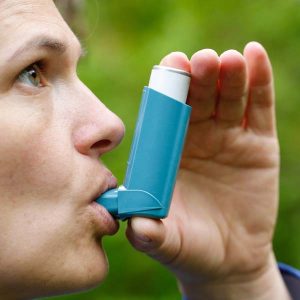
So, what’s it like to have diabetes and asthma?
Well, diabetes is a condition where the blood has high levels of sugar in it. It is normally caused by the body producing insufficient insulin. Symptoms of diabetes include excessive thirst, increased urination and blurred vision.
Asthma is a condition that causes patients to have trouble breathing, because of the swelling of the lungs airways. Symptoms of asthma include shortness of breath, tightening of the chest, wheezing and coughing.
So, mix these two together and that is what it’s like to have both diabetes and asthma. However, there is some good news if you have one of them, because there is some light at the end of this tunnel.
Contents
Is There a Link Between Asthma and Diabetes?

When it comes to asthma and diabetes, is there a link between the two? Well, we discussed what the two are and their symptoms above, so now let’s look in to the connection between the two. The answer is that people who have diabetes do have higher rates of having asthma. These patients do tend to have a hard time maintaining their blood glucose levels and keeping their asthma under control.
Further reading:
Throughout the years, various studies have shown that people who have diabetes that is not under control or is poorly maintained, are the ones who are at a higher risk of developing asthma, because their lung functioning seems to be weaker than those that have diabetes that is properly controlled or maintained.
On the reverse side, these studies also concluded that people who suffer from asthma are at a higher risk of developing diabetes and need to be careful.
Reasons Steroids and Diabetes Don’t Mix
Steroids are used in asthma patients to reduce the inflammation and swelling of the airways of the lungs. The most common steroids are cortisone and prednisone. So, how do these steroids affect blood glucose levels? Basically, steroids make it tough for the body’s cells to utilize insulin.
Let’s take a look at some patients with diabetes who also use steroids to control their asthma symptoms:
At diabetesdaily.com, user Andy957, has Type 2 diabetes, who was diagnosed with allergy-related asthma and uses an inhaler with steroids to control their asthma wants to know if other people with diabetes, who use inhalers have experienced problems? Note: this user has a Salbutamol inhaler for their asthma treatment and NovoRapid and Levemir for their diabetes treatment.
User furball64801 answered, “I do not use one but each time I get a steroid shot which is several times a year my bs can go as high as 300 or as low as the mid-100s so check often to see what your bs is.”
User chellecarlisle answered, “I've had to use my steroid inhaler since August and it did raise my BG from avg in the 80's to in the 90's, but not nearly as bad as if I would have needed a shot!”
Further reading:
- What Your Blood Sugar Meter Data is Telling You
- What Are The Best Ways To Lower Your Blood Sugar Levels?
Note: BG stands for Blood Glucose.
User nan OH answered, “I have chronic lung issues - any time I have to use my steroid medications my BGL goes up. I don't get upset about it anymore. If steroids keep me breathing and out of the hospital, then I will deal with a 230 BGL.” Note: BGL stands for Blood Glucose Level.
Experts Weigh in on Steroids Causing Diabetes
Do you want to know what some of the experts are saying about steroids and diabetes? Of course, you do because respiratory experts know the facts.
Respiratory experts, on asthma.net, were asked- Do asthma steroids cause diabetes? Here is what some of their answers were:
Corticosteroids can run the risks of severe side effects, some of these can cause additional health concerns. This method of treatment is often not recommended as a first option because it can affect other portions of the body and cause diabetes management to be more difficult. Additional steroids can cause your blood sugar levels to run much higher than recommended by your doctor. Long term use of steroids like prednisone can lead additional side effects like weight gain, mood swings, puffiness, insomnia, and difficulty with mood swings.
Asthma Attack Prevention is Key
So, one of the keys to managing asthma is to prevent an asthma attack.
Here are some ways you can prevent an asthma attack:
- Get rid of mold that may be in your home. Mold is a popular asthma trigger.
- Avoid secondhand smoke. Secondhand smoke can cause an asthma attack.
- Avoid using cleaners with harsh chemicals. Fumes from harsh chemical cleaners may trigger an asthma attack.
- Use a cool mist humidifier in your home. These gadgets are designed to release mist into the air, making the air feel fresh and cool.
- Use hypoallergenic items in your home, such as organic bedding, pollen-free plants and HEPA vacuum cleaners.
- Use HEPA filters in your home. These filters are designed to trap irritants like smoke and dust so they are not released back into the air.
- Avoid colds, flus and viruses. Viral infections can trigger asthma symptoms by harming your lungs.
Some patients have stated that even though summer usually isn’t an issue with asthma when the pollen count is higher in some areas, asthma symptoms can be more severe. Not everyone has the same symptoms when an asthma attack is coming on. Tightness in the chest, minor headaches, tingling sensation in the throat, the feeling of swollen glands and many more.
Attack Triggers
Asthma attacks can come on quickly and don’t always happen the same for everyone. Some have even reported that there are many things that can trigger an asthma attack. Some common triggers include:
- Smoke
- Pet Dander
- Infections
- Exercise
- Colder temperatures
- Pollen
- Insect Bites
- Some Chemicals
- Stress
Control Over Asthma and Diabetes
For those who have both diabetes and asthma, it is important to discover ways to control both conditions at the same time. Here are some tips to get you started:
Tips to Controlling Diabetes
- Eat a diet that consists of healthy foods like skinless chicken breasts, lean meats, vegetables, whole grains, cheese and skim milk. By eating a healthy diet, you can control your blood sugar levels better, have increased energy and maintain a healthy weight.
- Learn to deal with stress levels. Stress has been shown to raise your blood sugar levels.
- Check your blood pressure on a regular basis. You want to be sure you keep blood pressure readings at or below 129/79.
- Test your blood sugar levels before and after meals. Ideally, you want readings between 4 to 7 mmol/L before meals and under 8.5 mmol/L at least 90 minutes after meals.
- Drink green tea. Some studies have shown that green tea helps improve insulin sensitivity.
Read more about:
Tips to Control Asthma
- Eat a diet that consists of foods that contain Omega-3 fatty acids like salmon, spinach, navy beans and walnuts. Foods rich in Omega-3 help to decrease asthma susceptibility and reduce inflammation.
- Avoid foods that contain Omega-6 fatty acids like butter, mayonnaise, pork sausage and sunflower seeds. Foods that are high in Omega-6 can stop Omega-3 foods from being absorbed into the body and increase inflammation.
- If you are currently a smoker, stop smoking. Smoking damages your lungs, making your asthma symptoms worse.
- Maintain an asthma journal. At the end of each day, write down any asthma symptoms you may have experienced, what the causes of these symptoms were and what made the symptoms better. You can discuss these findings with your doctor so that your asthma plan may be adjusted as needed.
Tips to Control Diabetes and Asthma
- Avoid foods that contain trans-fat like hydrogenated oils, deep-fried foods, biscuits and doughnuts. Foods high in trans-fat put you at a higher risk for diabetes, inflammation and heart disease.
- Maintain a healthy weight. By maintaining a healthy weight, you can help maintain your blood sugar levels and your asthma symptoms.
What About Exercise, Asthma and Diabetes?
Exercise is one of the best ways to manage blood glucose levels, lower stress levels, promote weight loss and improve cholesterol levels. Exercise can also help with asthma symptoms by making your lungs stronger.
Learn more about how exercise and the proper diet can help you manage type 2 diabetes here.
So, what if you have asthma, use an inhaler and you notice high blood sugar levels after exercising? Here is what some viewers had to say about their own experience:
At tudiabetes.org, user Andrea Karim asked, “Are there any other asthmatic people with diabetes out there who have had a problem with higher BG after exercising with Albuterol?”
User Sheila Fitz answered, “OMG, yes, yes!!! I have had many problems with asthma this year after the heat went on when the weather got colder here in Chicago. Well, one day, I decided to go to Zumba, but brought my Albuterol. I used my inhaler between every song for the first half of the class struggling to get enough air and let my lungs relax. I got home and my bg was 126.”
Note: BG stands for blood glucose.
User Denise Bevard answered, “Oh yeah...and how much any of my asthma meds will raise my BG is dependent (according to my endo) how much makes its way through the lungs. So the better you are breathing the higher the BG goes.”
What Else Do I Need to Know About Diabetes and Asthma?
Before closing, I just wanted to provide you with some statistics regarding diabetes and asthma. For diabetes, The Centers for Disease Control and Prevention showed that in 2013, there were 27.3 million visits to doctor offices, in the United States, with the primary diagnosis of diabetes. Also, in 2013, there were 11.9 million emergency room visits, in the United States, with the primary diagnosis of diabetes. For asthma, The Centers for Disease Control and Prevention showed that in 2015, there were 18.4 million adults (ages 18 and older) in the United States, who currently have asthma.
So, the bottom line here is that if you have diabetes and asthma, the key to controlling both conditions is consistent physical activity, reduce stress levels and eat a healthy diet.
TheDiabetesCouncil Article | Reviewed by Dr. Sergii Vasyliuk MD on September 11, 2018











